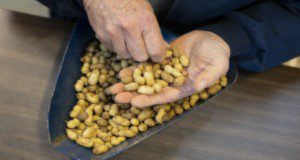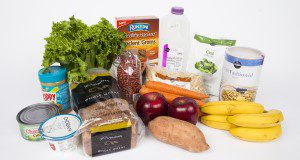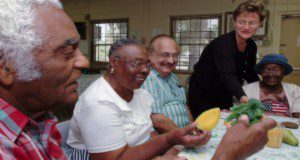Adults who are obese are often advised to lose weight to reduce the risk of chronic disease. However, the health benefits of weight loss change as we become older, and unintentional weight loss is linked to its own set of health risks. This new 3-page publication of the UF/IFAS Food Science and Human Nutrition Department discusses the risks and benefits of planned and unplanned weight loss for older adults. Written by Wendy Gans, Rachelle Savelle, Nancy J. Gal, and Wendy Dahl.
https://edis.ifas.ufl.edu/fs401
Tag: Nancy J. Gal
COAST: A Comprehensive Older-Adult Screening Tool
Nutrition risk screening is a first step to quickly identify individuals who might be malnourished or at risk of malnutrition. A malnutrition screening tool should be easy to use, quick to administer, and valid—able to correctly identify those at risk of malnutrition. The Comprehensive Older Adult Screening Tool (COAST) is a valid and practical tool to determine if community-dwelling older adults, specifically older adults of lower socioeconomic status, are at risk for malnutrition. This new 6-page publication of the UF/IFAS Food Science and Human Nutrition Department, written by Karima Alabasi, Nancy J. Gal, and Wendy J. Dahl, provides an introduction to COAST as well as the 5-question screening tool.
https://edis.ifas.ufl.edu/fs393
COAST-ES: Herramienta integral de tamizaje para adultos mayores
El tamizaje (cribado) del riesgo nutricional es un primer paso para identificar rápidamente a las personas que pueden estar desnutridas o en riesgo de desnutrición. Una herramienta de tamizaje de detección de desnutrición debe ser fácil de usar, rápida de administrar y válida para poder identificar correctamente a las personas en riesgo de desnutrición. La Herramienta Integral de Tamizaje de Adultos Mayores (COAST, por sus siglas en inglés) es una herramienta váida y práctica para determinar si los adultos mayores que viven en la comunidad están en riesgo de desnutrición.
This is the Spanish translation of FSHN20-37/FS393, COAST: A Comprehensive Older-Adult Screening Tool. Written by Karima Alabasi, Nancy J. Gal, and Wendy J. Dahl, translated by Daniela Rivero Mendoza, and published by the UF/IFAS Food Science and Human Nutrition Department.
https://edis.ifas.ufl.edu/fs396
Planificacion de comidas para la diabetes: manejo de la ingesta de carbohidratos
Mantener una ingesta constante de carbohidratos durante todo el día es un método eficaz de planificación de comidas para ayudar a mantener su objetivo de niveles de glucosa en sangre. Los alimentos que contienen carbohidratos tienen el mayor efecto sobre los niveles de glucosa en sangre en comparación con los alimentos que contienen principalmente proteínas o grasas. Los carbohidratos en los alimentos que contribuyen a la glucosa en la sangre incluyen azúcares y almidones. Los alimentos que contienen carbohidratos se dividen en grupos según su similar contenido de carbohidratos por porción. La cantidad de carbohidratos que consuma se basa en sus objetivos de tratamiento de la diabetes y la tolerancia a los carbohidratos.
This new 2-page article is the Spanish translation of FSHN20-1/FS324, Diabetes Meal Planning: Managing Your Carbohydrate Intake, written by Nancy J. Gal and Wendy J. Dahl, translated by Daniela Rivero Mendoza, and published by the UF/IFAS Food Science and Human Nutrition Department.
https://edis.ifas.ufl.edu/fs377
Planificacion de menu para adultos con diabetes
La nutrición, la actividad física y la medicación son los tres componentes principales de un plan de manejo de la diabetes. Según la Asociación Americana de Diabetes, no existe un plan específico de comidas para la diabetes. Si tiene diabetes, es importante desempeñar un papel activo en su autocontrol diario. Al trabajar con un Dietista Nutricionista Registrado (RDN), preferiblemente uno que sea un educador certificado en diabetes (CDE), puede desarrollar un plan de nutrición personalizado basado en sus objetivos de tratamiento, medicamentos y preferencias personales.
This new 2-page article is a translation of FSHN19-3/FS323, Meal Planning for Adults with Diabetes, written by Nancy J. Gal and Wendy J. Dahl, translated by Daniela Rivero Mendoza, and published by the UF/IFAS Food Science and Human Nutrition Department.
https://edis.ifas.ufl.edu/fs376
Diabetes Meal Planning: Managing Your Carbohydrate Intake
If you have diabetes, maintaining a consistent carbohydrate intake throughout the day is an effective meal-planning method to help maintain your target blood glucose levels. Foods that contain carbohydrates have the greatest effect on blood glucose levels compared to foods that contain primarily protein or fat. Carbohydrates in foods that contribute to blood glucose includes sugars and starches. The amount of carbohydrate you consume is based on your diabetes treatment goals and carbohydrate tolerance. This new 3-page publication of the UF/IFAS Food Science and Human Nutrition Department, written by Nancy J. Gal and Wendy J. Dahl, provides a strategy for planning your daily menu to manage your carbohydrate intake.
https://edis.ifas.ufl.edu/fs324
Bebidas nutricionales suplementarias: Las necesito?
Las bebidas nutricionales suplementarias a menudo se usan en hospitales y hogares de adultos para ayudar a nutrir a quienes pueden comer mal y han perdido peso debido a una enfermedad o falta de apetito. Más recientemente, las bebidas nutricionales están disponibles para la compra de los consumidores. Ejemplos de bebidas o batidos nutricionales suplementarios comunes son Ensure® y Boost®. Esta publicación explora la pregunta que muchos adultos mayores se hacen: “¿Necesito bebidas nutricionales suplementarias?”
This new 3-page publication of the UF/IFAS Food Science and Human Nutrition Department is a Spanish translation of FSHN18-12/FS315, Supplemental Nutrition Drinks: Do I Need Them? Written by Claire Marie Fassett, Nancy J. Gal, and Wendy J. Dahl, and translated by Daniela Rivero Mendoza.
https://edis.ifas.ufl.edu/fs321
Sal: ¿Debo recortar su consumo?
La sal alimentaria está compuesta de sodio y cloruro, dos minerales esenciales necesarios para una buena salud. El sodio es muy importante para nuestro cuerpo para mantener el equilibrio de líquidos, el volumen de sangre y la presión arterial. Sin embargo, muchas personas consumen más sodio en la dieta (de la sal) que lo que se necesita. La disminución de sodio en la dieta ha recibido mucha atención en los últimos años debido a la asociación del alto consumo de sodio en la dieta con hipertensión (presión arterial alta) y enfermedad cardiovascular. Esta publicación explora los efectos en la salud de la ingesta excesiva de sodio y las formas de disminuir la ingesta de este mineral.
This new 3-page publication of the UF/IFAS Food Science and Human Nutrition Department is the Spanish version of FSHN 18-9/FS312: Salt: Should I Cut Back? Written by Asmaa Fatani, Nancy J. Gal, and Wendy J. Dahl, and translated by Daniela Rivero Mendoza.
https://edis.ifas.ufl.edu/fs320
Supplemental Nutrition Drinks: Do I Need Them?
Supplemental nutrition drinks are often used in hospitals and adult care homes to help nourish those who may be eating poorly. More recently, these drinks have become available for purchase by consumers. This 2-page publication explores the question that many older adults ask: “Do I need supplemental nutrition drinks?” Written by Claire Marie Fassett, Nancy J. Gal, and Wendy J. Dahl and published by the UF/IFAS Department of Food Science and Human Nutrition, August 2018.
http://edis.ifas.ufl.edu/fs315
Salt: Should I Cut Back?
Sodium is important for our body to maintain fluid balance, blood volume, and blood pressure; however, many people consume more dietary sodium (from salt) than needed. This 3-page publication explores the health effects of excessive sodium intake and ways to decrease intake of this mineral. Written by Asmaa Fatani, Nancy J. Gal, and Wendy J. Dahl and published by the UF/IFAS Department of Food Science and Human Nutrition, August 2018.
http://edis.ifas.ufl.edu/fs312
CKD: A Guide to Higher Fiber Foods
Living with chronic kidney disease (CKD) presents many challenges, and diet is one of them. People with CKD may find it difficult to consume enough fiber-rich foods while following the other diet recommendations for CKD. This 5-page guide will discuss the health benefits of fiber and provide some examples of fiber-rich foods that may be good choices for people with CKD. Written by Wendy J. Dahl and Nancy J. Gal and published by the UF/IFAS Department of Food Science and Human Nutrition, January 2018.
http://edis.ifas.ufl.edu/fs305
Sick Day Management for Adults with Diabetes Who Take Insulin
When people have type 1 or type 2 diabetes and take multiple daily insulin injections, their blood glucose levels can rise drastically due to a cold or another minor illness. This can result in serious health problems. The best way for people with diabetes to prevent a minor illness from becoming a major illness is to have a personalized sick day plan designed with their health care provider before they become ill. This 4-page fact sheet is a major revision that discusses ways in which illness affects diabetes control, development of a sick day plan, times to call your health care provider, checking blood glucose and urine ketones, medicines, and diet. Written by Nancy J. Gal and Linda B. Bobroff, and published by the UF Department of Family, Youth and Community Sciences, revised June 2017.
http://edis.ifas.ufl.edu/fy1281
Chronic Kidney Disease: Potassium and Your Diet
Potassium is an essential mineral required for normal body function. It helps maintain normal blood pressure, fluid and electrolyte balance, muscle and nerve function, as well as bone density. This three-page fact sheet describes potassium and its normal dietary importance, as well as the impact potassium levels have on those with Chronic Kidney Disease. Written by Ashley R. Kendall, Nancy J. Gal, and Wendy J. Dahl and published by the Food Science and Human Nutrition Department.
http://edis.ifas.ufl.edu/fs287
Diabetes-Related Websites
Managing diabetes requires learning about your disease, making positive lifestyle choices, and being a partner with your health care team. Finding and using current and reliable sources of health information on the Internet also helps you make choices that support your health while avoiding potentially harmful products and practices. This 1-page fact sheet is a major revision that provides links to government, educational, and recognized professional websites on diabetes. Written by Linda B. Bobroff and Nancy J. Gal, and published by the UF Department of Family, Youth and Community Sciences. Revised May 2016.
http://edis.ifas.ufl.edu/fy1103
Vivir con Diabetes
La diabetes es una enfermedad que afecta a más de 29 millones de estadounidenses. Aunque no existe cura para tipo 1 o tipo 2 diabetes, con los cuidados necesarios se puede controlar la enfermedad.
This 5-page fact sheet is the Spanish version of Living with Diabetes. This major revision provides an overview of diabetes, a list of people at high risk of developing the disease, and a description of each type of diabetes. It also discusses tests, possible health problems, control of blood glucose, and diabetes management. Written by Nancy J. Gal and Linda B. Bobroff, and published by the UF Department of Family, Youth and Community Sciences, revised May 2016.
http://edis.ifas.ufl.edu/fy924
Chronic Kidney Disease: Phosphorus and Your Diet

Phosphorous is an essential mineral necessary for the formation of bones and teeth, but also for kidney function and the regulation of muscle contractions, heartbeat, and nerve transmission. High blood levels of phosphorus may lead to adverse effects on bone, kidney, and heart health. When there is too much phosphorus in the blood, the body reacts by leaching calcium from the bones. This can be especially dangerous for those with Chronic Kidney Disease. This four-page fact sheet discusses the relationship between Chronic Kidney Disease and Phosphorous intake, examining foods that are high in phosphorous and ways to manage phosphorous levels. Written by Nancy J. Gal, Lauren Headrick, Kate Bennett, and Wendy J. Dahl, and published by the Food Science and Human Nutrition Department.
http://edis.ifas.ufl.edu/fs273
Datos sobre el fosforo
 El fósforo es un mineral que se encuentra en todas las células del cuerpo, por lo general en forma de fosfato. Es el segundo mineral más abundante en el cuerpo después del calcio. Alrededor del 85% del fósforo se almacena en los huesos y dientes. Es importante para la formación de huesos y dientes, además de la reparación de huesos.
El fósforo es un mineral que se encuentra en todas las células del cuerpo, por lo general en forma de fosfato. Es el segundo mineral más abundante en el cuerpo después del calcio. Alrededor del 85% del fósforo se almacena en los huesos y dientes. Es importante para la formación de huesos y dientes, además de la reparación de huesos.
This 3-page fact sheet was written by Nancy J. Gal y Wendy J. Dahl, and published by the UF Department of Food Science and Human Nutrition, August 2014.
http://edis.ifas.ufl.edu/fs252
Datos sobre los Carbohidratos
 Los carbohidratos, grasas y proteínas son los tres nutrientes que proveen energía (calorías). Sin embargo, los carbohidratos como los almidones y azúcares son la fuente más importante y principal de energía. Durante la digestión, el almidón se rompe en azúcares (glucosa). Los carbohidratos en forma de glucosa proveen energía a las células, tejidos y órganos para llevar a cabo las actividades diarías. Alguna glucosa se almacena en el hígado y células de los músculos para usarla cuando se requiera. Los niños necesitan carbohidratos para el crecimiento y los adultos necesitan para mantener el peso. This 3-page fact sheet is the Spanish language version of Facts about Carbohydrate, written by Nancy J. Gal, Amanda L. Ford and Wendy J. Dahl, and published by the UF Department of Food Science and Human Nutrition, July 2014.
Los carbohidratos, grasas y proteínas son los tres nutrientes que proveen energía (calorías). Sin embargo, los carbohidratos como los almidones y azúcares son la fuente más importante y principal de energía. Durante la digestión, el almidón se rompe en azúcares (glucosa). Los carbohidratos en forma de glucosa proveen energía a las células, tejidos y órganos para llevar a cabo las actividades diarías. Alguna glucosa se almacena en el hígado y células de los músculos para usarla cuando se requiera. Los niños necesitan carbohidratos para el crecimiento y los adultos necesitan para mantener el peso. This 3-page fact sheet is the Spanish language version of Facts about Carbohydrate, written by Nancy J. Gal, Amanda L. Ford and Wendy J. Dahl, and published by the UF Department of Food Science and Human Nutrition, July 2014.
http://edis.ifas.ufl.edu/fs250
Facts about Carbohydrate
 Carbohydrate, fat, and protein are the three nutrients that provide energy (calories). However, carbohydrate from starch and sugars is our main and most important source of energy. During digestion, starch is broken down to sugar (glucose). Carbohydrate in the form of glucose provides energy to cells, tissues, and organs to carry out daily activities. Some glucose is stored in the liver and muscle cells for later use when required. Children need carbohydrate for growth, and adults need carbohydrate to maintain their weight. This 3-page fact sheet was written by Nancy J. Gal, Amanda L. Ford, and Wendy J. Dahl, and published by the UF Department of Food Science and Human Nutrition, February 2014.
Carbohydrate, fat, and protein are the three nutrients that provide energy (calories). However, carbohydrate from starch and sugars is our main and most important source of energy. During digestion, starch is broken down to sugar (glucose). Carbohydrate in the form of glucose provides energy to cells, tissues, and organs to carry out daily activities. Some glucose is stored in the liver and muscle cells for later use when required. Children need carbohydrate for growth, and adults need carbohydrate to maintain their weight. This 3-page fact sheet was written by Nancy J. Gal, Amanda L. Ford, and Wendy J. Dahl, and published by the UF Department of Food Science and Human Nutrition, February 2014.
http://edis.ifas.ufl.edu/fs243
Facts about Phosphorus
 Phosphorus is a mineral found in every cell of the body, usually in the form of phosphate. It is the second most abundant mineral in the body after calcium. About 85% of phosphorus is stored in the bones and teeth. It is important for forming bones and teeth, as well as repairing bones. This 3-page fact sheet was written by Nancy J. Gal and Wendy J. Dahl, and published by the UF Department of Food Science and Human Nutrition, January 2014.
Phosphorus is a mineral found in every cell of the body, usually in the form of phosphate. It is the second most abundant mineral in the body after calcium. About 85% of phosphorus is stored in the bones and teeth. It is important for forming bones and teeth, as well as repairing bones. This 3-page fact sheet was written by Nancy J. Gal and Wendy J. Dahl, and published by the UF Department of Food Science and Human Nutrition, January 2014.
http://edis.ifas.ufl.edu/fs237









